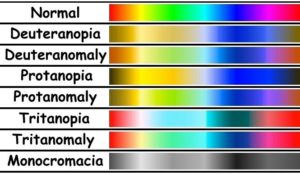What is Colour Blindness and What Causes it?
- Difficulty distinguishing colours (blue and yellow or red and green)

- Colour blind people see things as clearly as other people but they are unable to fully ‘see’ read, green or blue light
- Inherited condition that affects males more frequently than females and this condition is related to deficiencies or absence in certain types of cones
- Occurs when light sensitive cells in retina fail to respond properly to variations in wavelengths of light that enable people to see an array of colours
- Rods and cones are photoreceptors in the retina
- Rods: more plentiful and are more sensitive to light and are incapable of perceiving colour
- Cones: responsible for colour vision, mostly found in the central zone of the retina, the macula
- Center of macula is called fovea and it contains the highest concentration of cones in the
retina is responsible for our most acute color vision
Treatment and Strategies
- There is no cure, but rather coping strategies that may help you function in a colour-orientated world
- Diagnosing colour vision deficiency early on in life may prevent learning problems in school years
- Some people use special lenses to enhance colour perception, which are filters available in contact lens form or eyeglasses (they are limited and mostly found in US)
Types of Colour Blindness
- Trichromacy: normal colour vision
- Anomalous Trichromacy: all three cone types are used to perceive light colours but one type of cone perceives light slightly out of alignment, so there are 3 different types of effect produced depending upon which cone type is ‘faulty’.
- Dichromacy: only two types of cones which are able to perceive colour (i.e they have a total absence of function of cone type). Lack of ability to see colour is a good way to explain this condition, but in fact it is a specific section of the light spectrum which cannot be perceived.
- Monochromacy: can see no colour at all, they see different shades of grey ranging from black to white
Red-Green Colour Blindness
- Most common form; red and green are the main problem colours
- Red-green colour blindness is split into two subtypes;
- Protan colour vision deficiency – responsible for red part of vision – person either lack or have anomalous long wavelength sensitive cones
- Deutan colour vision deficiencies – responsible for green part of vision
- Dichromats: Deuteranopia (green-blind/strong); medium wavelength sensitive cones are missing, person can only distinguish 2 to 3 different hues (normal vision can see 7 different hues)
- Anomalous Trichromats: Deuteranomaly (green-weak); green sensitive cones are not missing in this case, but rather the peak of sensitive is moved towards the red sensitive cones.
Blue – Yellow Colour Blindness
- Blue – cone (tritan) photo pigments are with missing or have limited function
- Tritanomaly: functionally limited blue cone cells. Blue appears greener and it can be difficult to tell yellow and red from pink.
- Tritanopia: blue-yellow colour blindness, lack blue cones cells. Blue appears green and yellow appears violet or light grey.
- Tritan defects can not only be inherited by also acquired during one’s lifetime
- Among alcoholics – large alcohol consumption may result in poorer colour discrimination in all spectra but with significantly more errors blue-yellow
- An injury through hard hit to the front or back of your head
- With age, eye lens becomes less transparent
- Diabetes
How is Colour Blindness Diagnosed?
- Ishihara Colour Test: most common test for red-green colour blindness. The test consists of a series of coloured circles in different colours and sizes. Within the circle are dots that form a shape clearly visible to people with normal vision but invisible/difficult to see for those with red-green colour blindness
- Cambridge Colour Test: uses a visual array similar to the Ishihara plates, except displayed on a computer monitor. Goal is to identify a C shape that is different in colour from the background.
- D-15 Test : based on a set of coloured plates or discs which have to be arranged in the correct order. Colour blind people will have difficulties to arrange the given colours and make mistakes.
- The test can differentiate between protan, deutan and tritan colour vision deficiencies
- Calculate an approximate severity of your colour blindness
- D-15 test CANNOT: detect some weak forms of colour vision deficiency and differentiate between dichromacies and anomalous trichromacies
Professions that prohibit people with colour blindness:
- Operating motor vehicles
- Electrician
- Pilot’s license
- Firefighter
- Baggage handler
- Police officer

Comments are closed.